The Disappearing Poor
Exploring the incredible worldwide gains in prosperity: Reality Project Episode 1
Every day for 25 years, newspapers could have correctly run the headline “130,000 People Escape Extreme Poverty Yesterday” (source). Instead, as far as I can tell, this has appeared on the front page of a major newspaper precisely 0 times. Maybe this explains the incredibly terrible results recorded by people on this simple question (from Gapminder):
 Question 1. of the Gapminder test
Question 1. of the Gapminder test
When this question was asked in the United States, 5% of humans got the correct answer, C: almost halved. Animals, on the other hand, answer this question with 33% accuracy (because they randomly guess).
How is it possible for people in a supposedly literate society like the US to be so wrong about reality? I don’t like to place blame, but in this case, it’s likely justified: the media has succeeded in a campaign to misinform us about the world. Instead of reporting facts, they have chosen to activate our natural inclination towards xenophobia (fear of outsiders) by convincing us there is a “developed world” with well-off people, and then there is everyone else, a mass of poor hordes that will never be able to rise from poverty.
Fortunately, armed with the right data, we can correct our wrong beliefs about poverty. On doing so, we discoverable a remarkable fact: over the past few decades, people all over the world have undergone a remarkable increase in prosperity, resulting in measurably better living standards for billions of people.
This is episode one of the Reality Project, a weekly series dedicated to becoming less wrong about the world with data.
The Facts about Global Poverty and Income
First, we need to look at the statistics. The single best resource on this topic is the Our World in Data “Global Extreme Poverty” page. You can view all the numbers there, but one chart suffices to show the drastic decline in poverty:
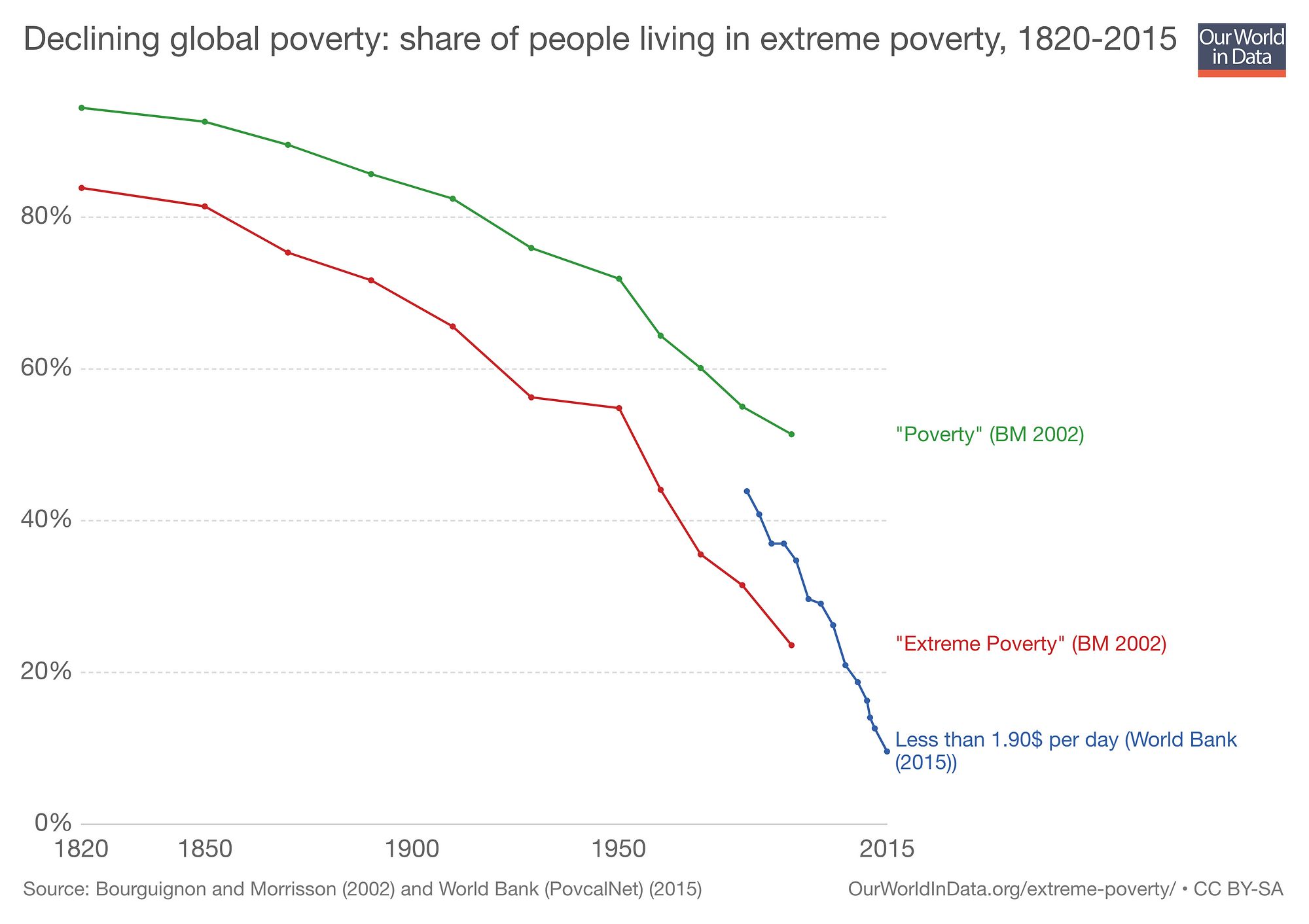 Global share of the world population in extreme poverty.
Global share of the world population in extreme poverty.
We can see that the definition of poverty varies by institution, but no matter which definition we use, the rates have drastically increased. Sure, the rate is decreasing, but because there are more people, doesn’t that mean more people are still poor?
Nice try nightly news, but the number of people living in poverty has also declined precipitously, by over 1.2 billion since 1990.
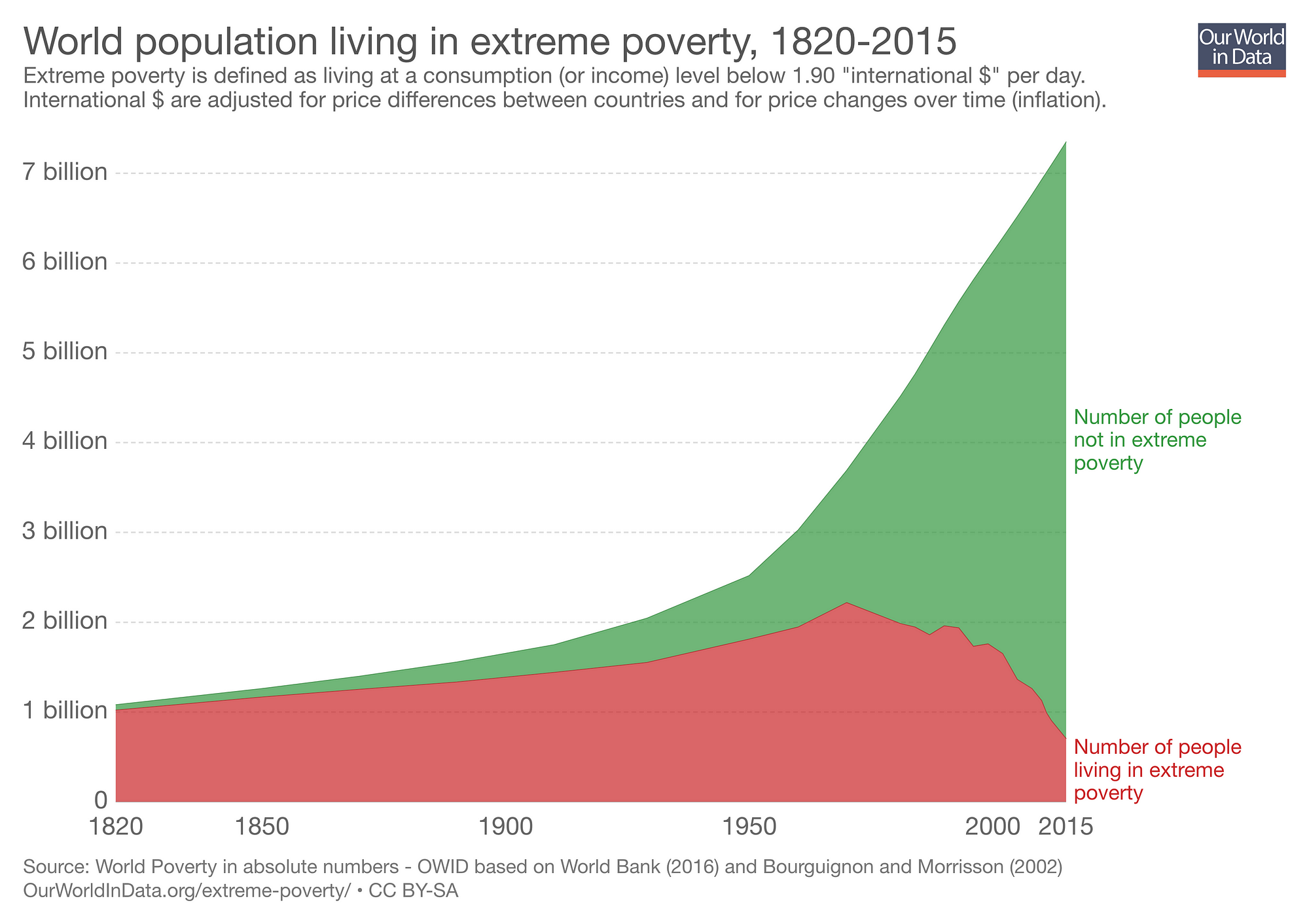 Number of people living in extreme poverty.
Number of people living in extreme poverty.
Where do these people go as they rise from extreme poverty? Simple: into the global middle class. As of this writing, about 85% of people in the world (6 billion out of 7 billion) are at or above the middle part of the global income scale. Making a distinction between “developed” and “developing” is the wrong way of looking at the world: there are not two income levels, but rather a smooth scale which people everywhere are rapidly climbing.
We can observe the drastic increase in worldwide wealth in the numbers. As global poverty declines, incomes increase as shown in GDP per capita over time (from the Our World in Data “Economic Growth” page):
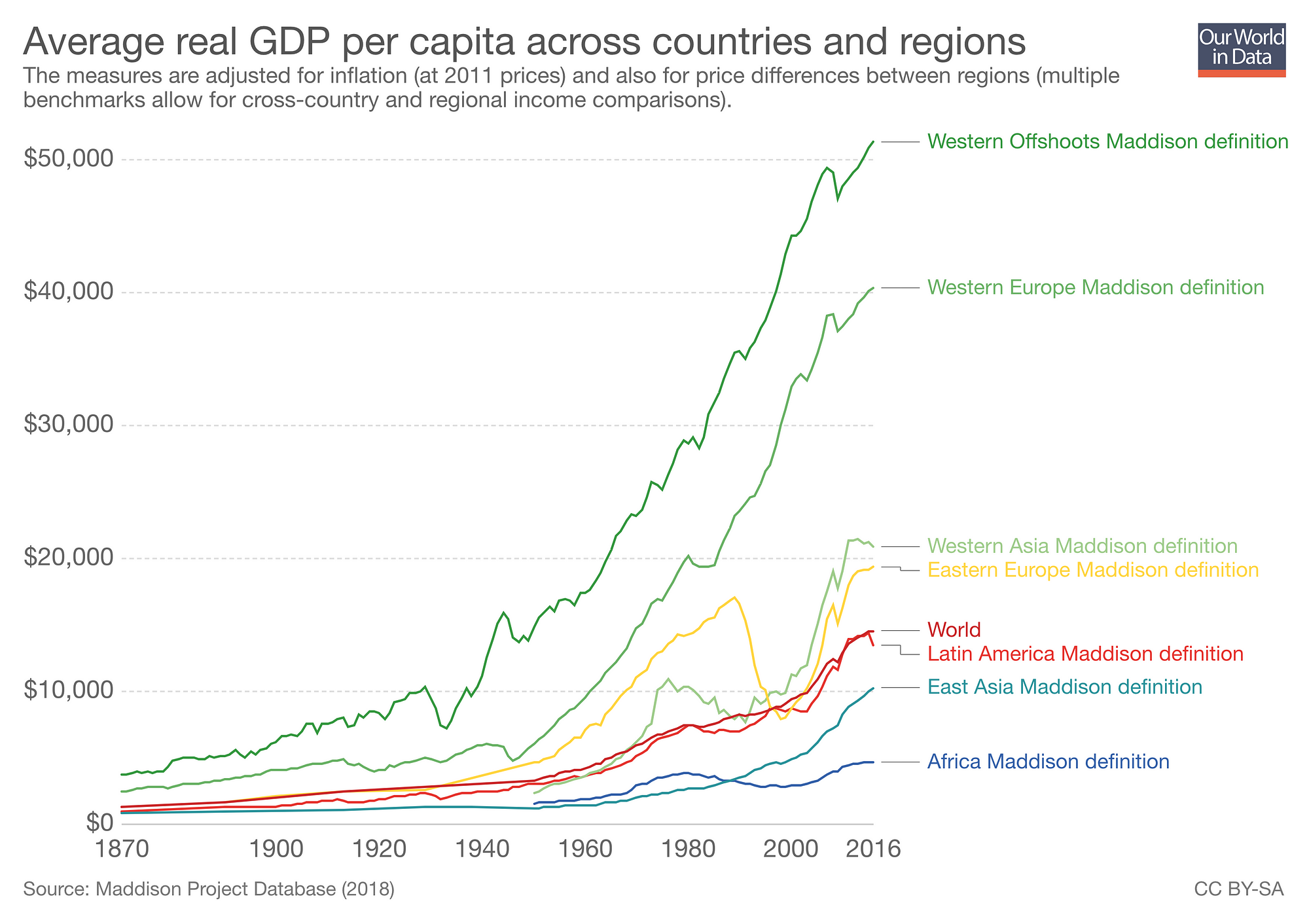 Gross Domestic Product Per Capita around the world.
Gross Domestic Product Per Capita around the world.
So, the facts are unequivocal that poverty is declining and incomes are increasing at an extremely rapid pace, but does this actually matter? It is possible that people are making more money but not having better lives?
Why Wealth Matters: Rich Countries are Better Places to Live
All of this may look nice, but you may be wondering if the rise in wealth actually means that people are better off. Well, based on the following chart showing life dissatisfaction vs GDP per capita, the answer is a resounding yes.
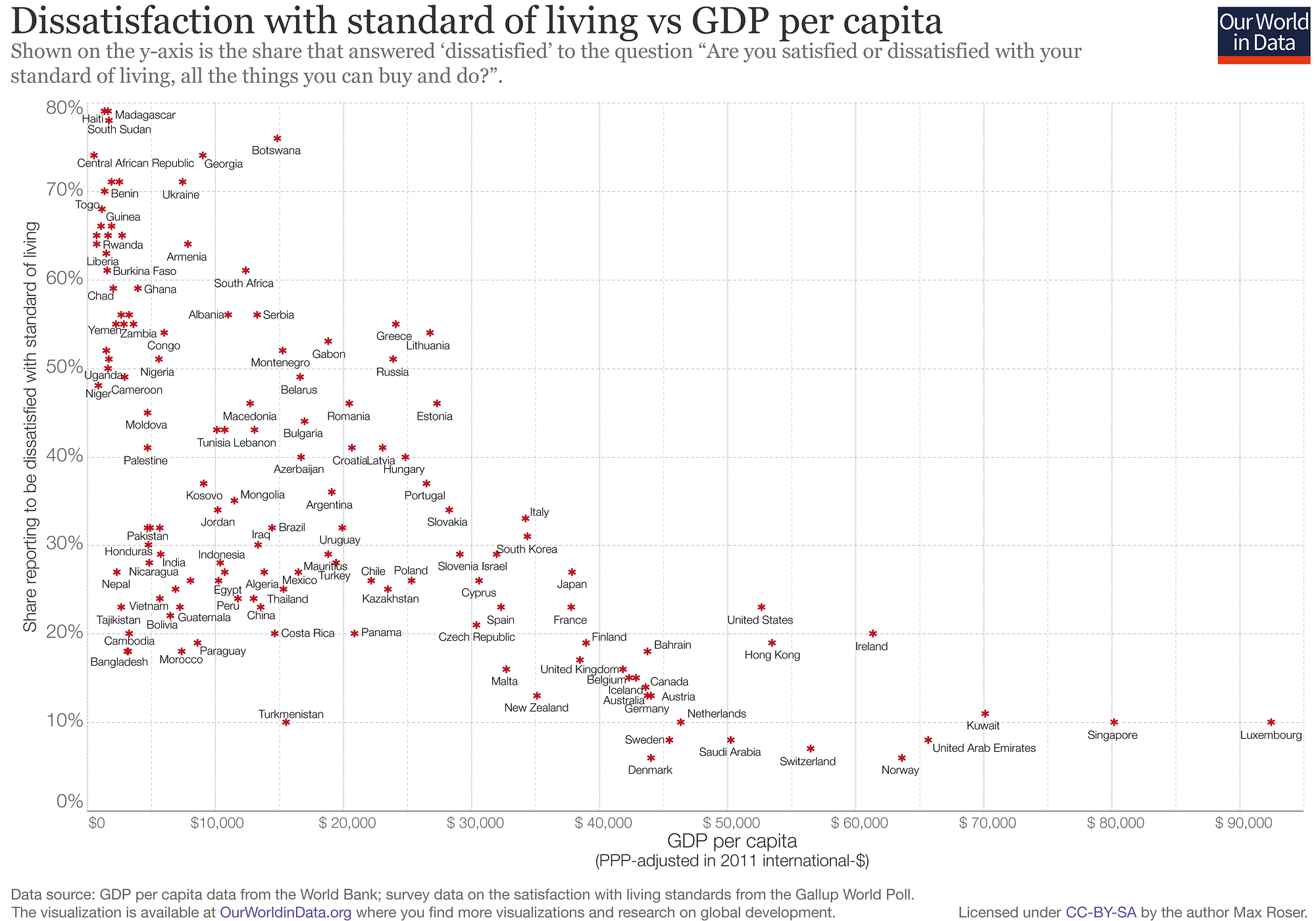 Dissatisfaction in Living vs GDP (Source)
Dissatisfaction in Living vs GDP (Source)
As wealth increases, people become more satisfied with life. Money is not a magical cure for all ills, and the effects only persist up to a certain income level but wealth is positive because of the side effects it brings with it: lower infant mortality, more educational opportunities, and fewer working hours.
It can be easy to lose sight of the humans in all the numbers so it’s critical to remember that behind every one of these data points is a person. Billions of people rising out of poverty means mothers who don’t have to bury their children because care improves with wealth, girls who are able to attend high school, and families that are living healthier, happier lives. I’m not very good at talking about individual humans, but Hans Rosling provides stories (in addition to facts) in his excellent book Factfulness.
As for me, I’ll end this section with another chart from Our World in Data which demonstrates why less poverty is positive:
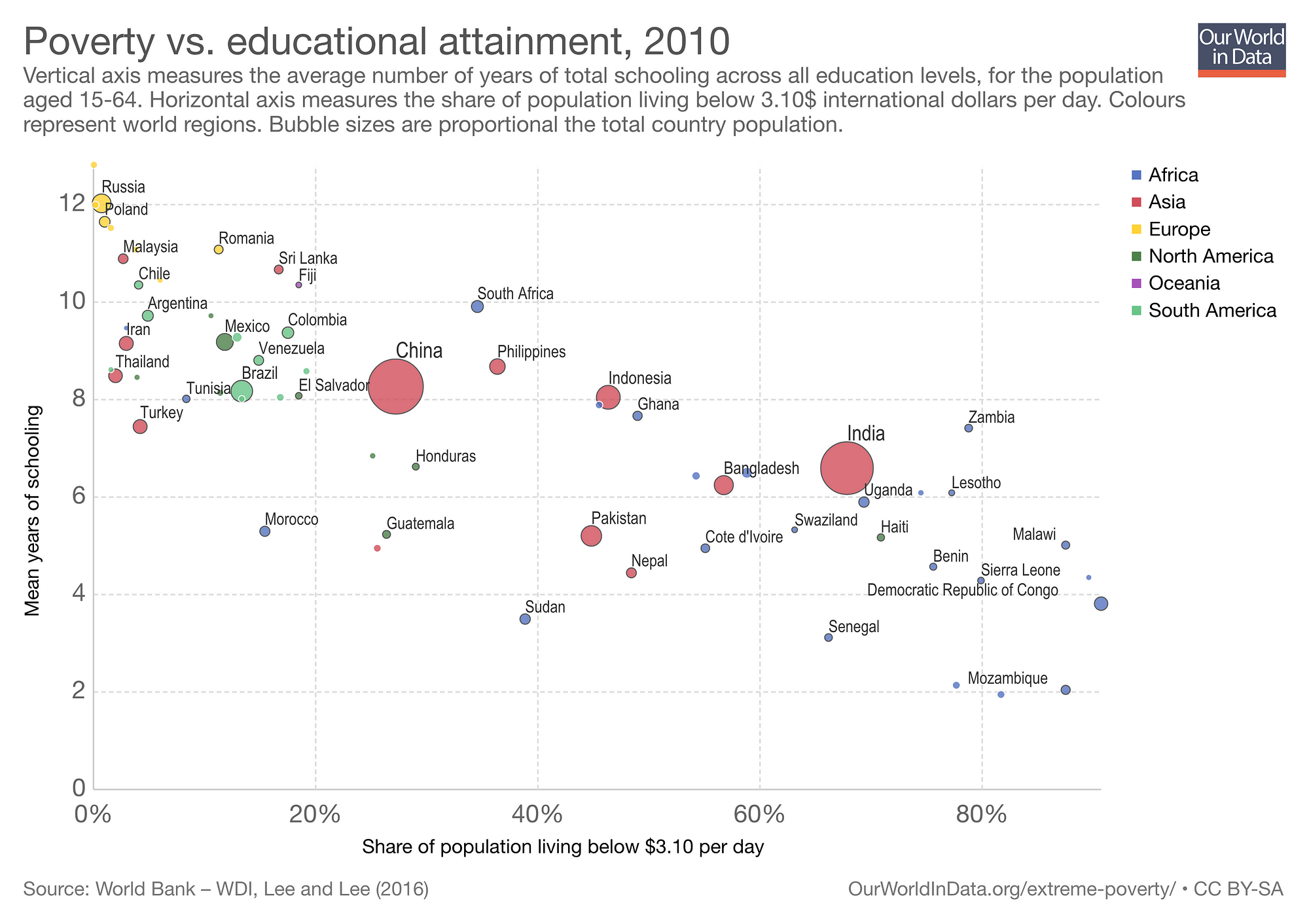 Average Number of Years of Schooling vs Poverty Levels
Average Number of Years of Schooling vs Poverty Levels
The data could not be more clear: around the world, humans are rising out of poverty and into the middle class. As a consequence, they are living longer, going to school more, working less, and leading more enjoyable lives.
Cause of the global decline in poverty
There are likely many factors at play behind this decline (as with any human phenomenon) but I’ll focus on the most compelling argument: commerce. (For a full treatment of this subject, see Matt Ridley’s The Rational Optimist).
For hundreds of thousands of years, humans engaged in zero-sum interactions: one person stole or killed another person, so someone’s gain was offset by someone else’s loss. In this system, the overall state of humanity could improve only glacially if at all ( very slowly when communication was limited to walking speed).
However, beginning around 1000 AD in Europe, a new form of interaction emerged: economic exchanges in which both parties came out better off. This invention, known as commerce, completely changed the game: people were now able to enter into positive-sum exchanges where both parties gained. This is a fundamental building block of civilization: in commerce, both the person selling a good and the person buying a good come out ahead.
For most of history, humanity had a constant amount of material wealth which could change hands but did not increase overall. With the invention of commerce, the size of the economic pie itself increases as people trade goods and specialize. Both within and between country exchanges lead to a division of labor wherein people or countries specialize in fulfilling one role, leading to massive increases in efficiency. It took humans a long time to figure out, but once we created exchanges and market economies, we started on the incredible upward journey in wealth that continues to this day.
We can see the beneficial effects of trade in recent years on the following chart. As countries trade more, they grow wealthier:
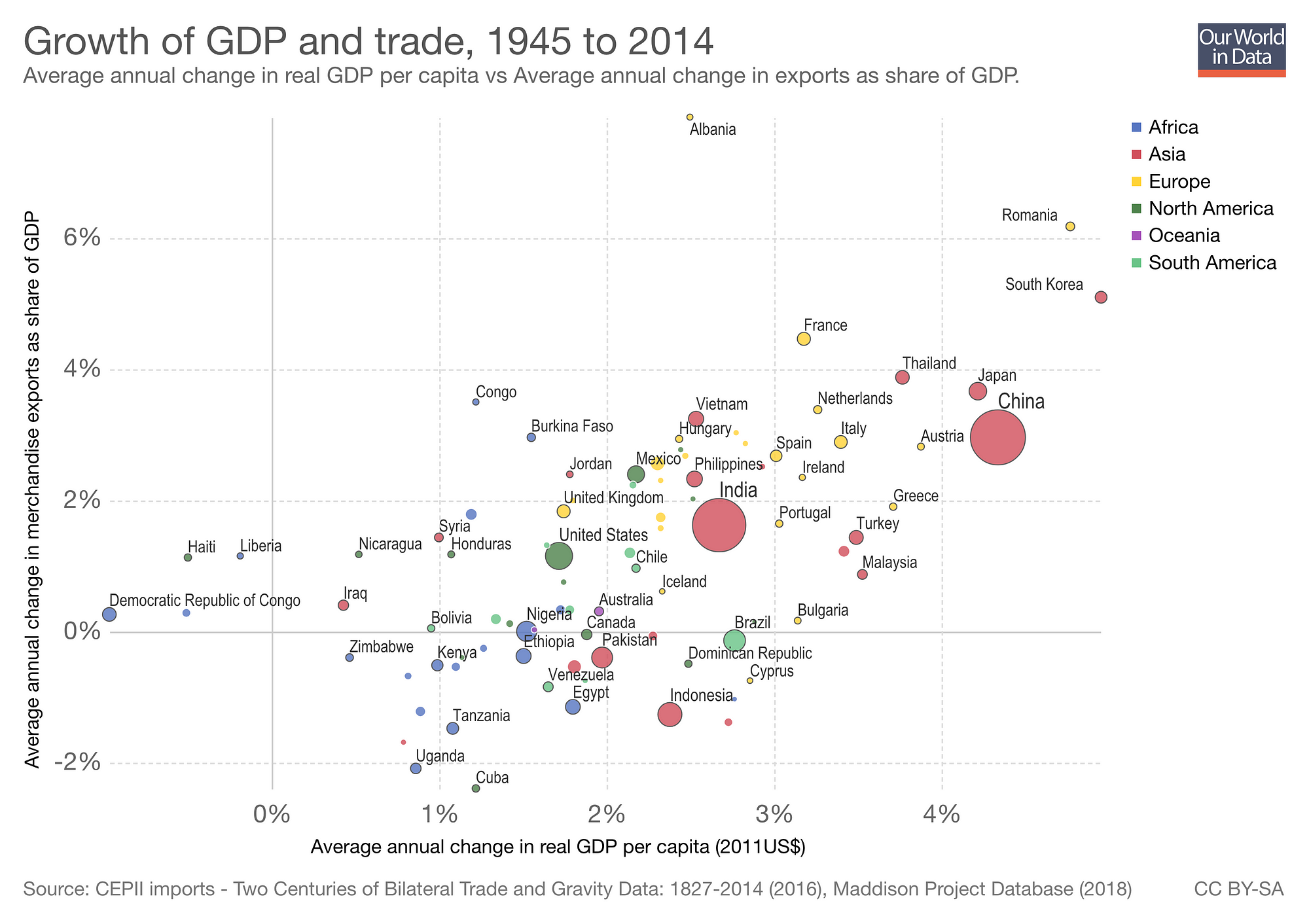 Change in trade 1945–2014 versus change in wealth
Change in trade 1945–2014 versus change in wealth
Don’t mistake me for a free-market evangelist. Before I began my efforts to get less wrong about the world through data, I was an avowed Socialist who upheld the Nordic countries as paragons to emulate. However, my exploration of the numbers has led to the conclusion that free markets and the exchange they enable are the drivers for escaping poverty. I also still believe in the role of government: tight government controls in areas like environmental protection and worker rights are critical for making sure that increased wealth does not come at the cost of environmental devastation.
The remarkable ability of commerce to lift people out of poverty can be seen in China, which over the past 40 years has undergone the most incredible wealth increase in history. As described in How China Escaped the Poverty Trap, China’s extraordinary escape from poverty occurred as the communist leaders gradually opened the nation to commerce, crucially, trade with other nations. In 1978, China allowed foreign trade, and in the 40 years since, has once again become a world power. Along the way, the living standards of hundreds of millions of people has been raised.
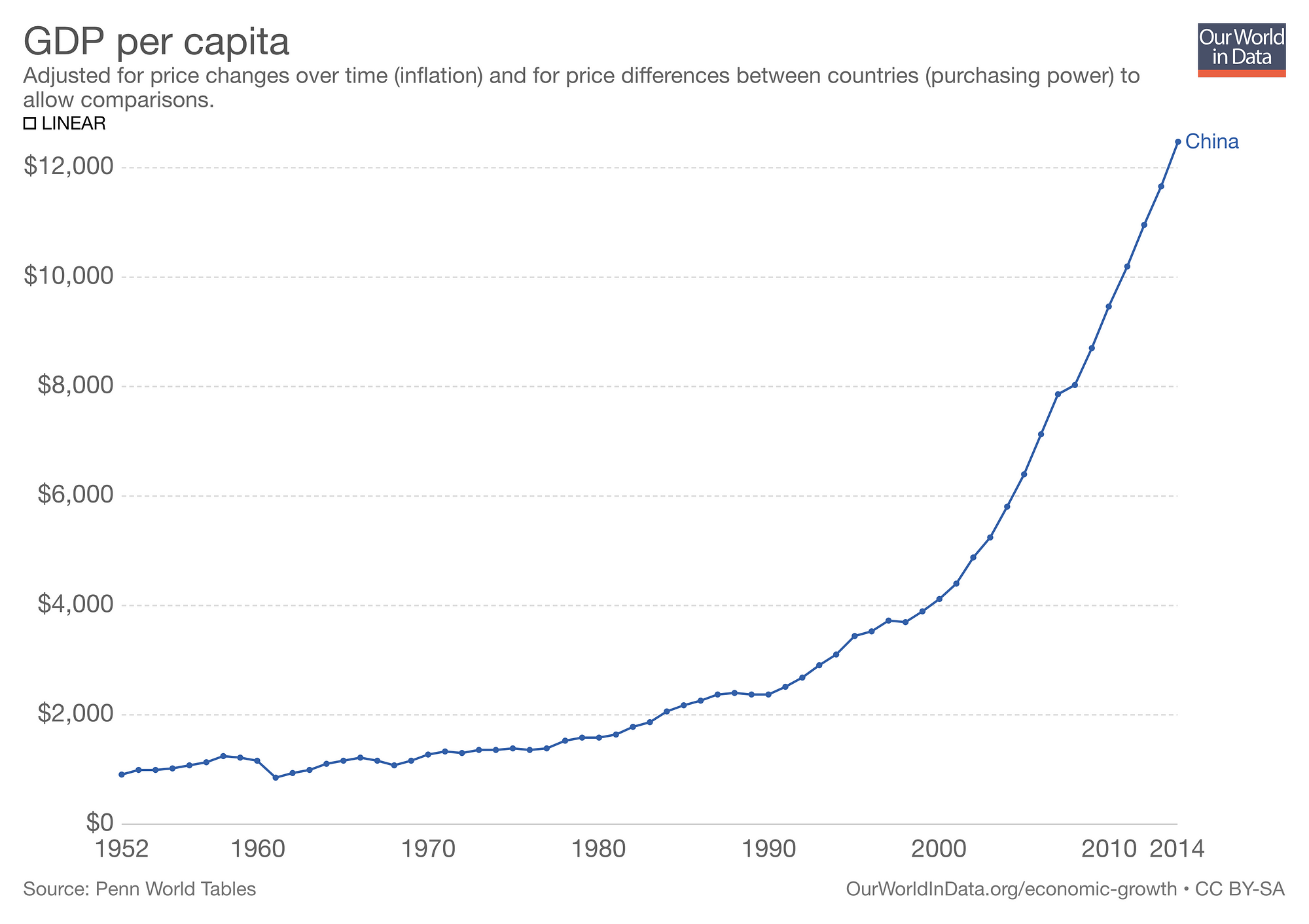 China’s incredible rise in GDP per capita
China’s incredible rise in GDP per capita
(Not only does commerce lead to rising income, but it also leads to decreasing rates of violence within and between nations. As documented by Steven Pinker in The Better Angels of Our Nature, when it is cheaper to buy something from someone than to steal it, economics wins out. Our neighbors become more valuable to us alive than dead which means less killing and more trading. This is known as the theory of gentle commerce.)
Caveats
While the long-term picture is overwhelmingly positive, it’s important to also focus on the realities that still need to be improved. At the moment, there are remain hundreds of millions of people in extreme poverty around the world and every one of these people deserves to rise into the middle class. The unfortunate reality is that the vast proportion of the world’s poor are in Africa where groups like the United Nations are working to end poverty through targeted spending programs and the institution of social safety nets.
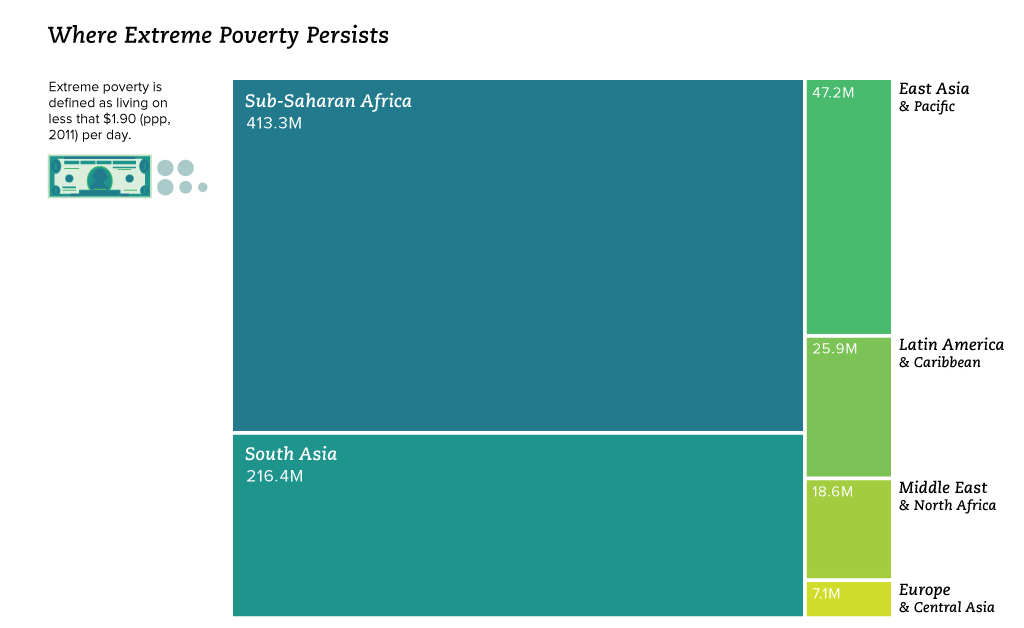 Where extreme poverty still exists (source)
Where extreme poverty still exists (source)
There are around 750 million people still in extreme poverty today. Nonetheless, considering 1.2 billion people moved out of extreme poverty from 1990–2015, there is every indication that extreme poverty can be ended.
Furthermore, any time the issue of income is brought up, we have to mention income inequality. If countries are getting richer, but the wealth is going to fewer people, then is humanity really better off?
Once again, it’s worth looking at the data, this time on inequality both within and between countries. We’ll turn to the Our World in Data articles “Income Inequality” and “Global Economic Inequality” for the facts. Fortunately, the numbers again provide an optimistic answer. While within-country inequality has increased in a few countries, overall, global inequality has decreased and is projected to continue to decrease.
From the following plot, we can see that some countries have experienced an increase in inequality within their borders if we define inequality as the share of total income going to the top 1%. (This definition may have some issues).
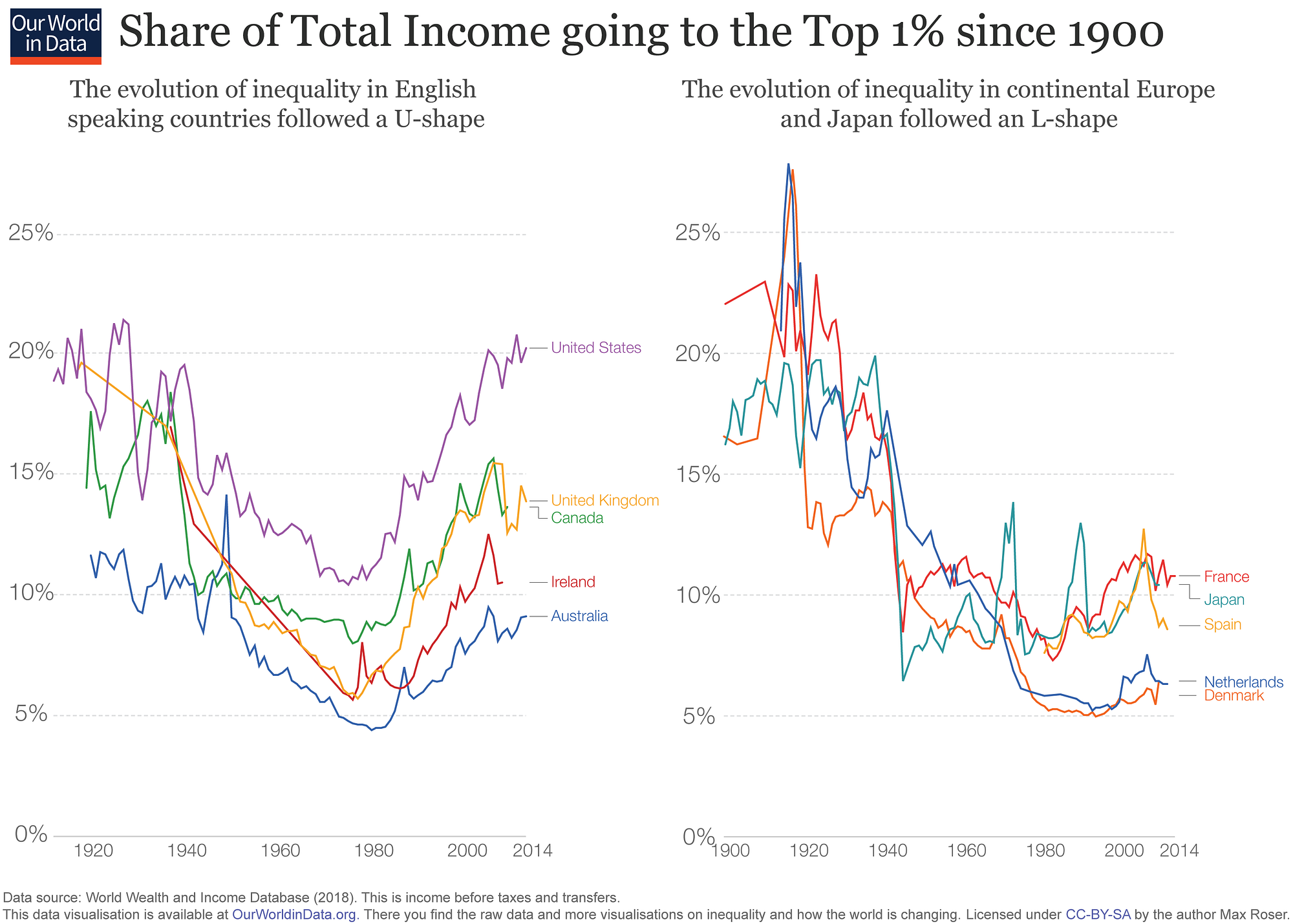 Share of income going to top 1% in selected nations.
Share of income going to top 1% in selected nations.
On the other hand, global economic inequality has declined:
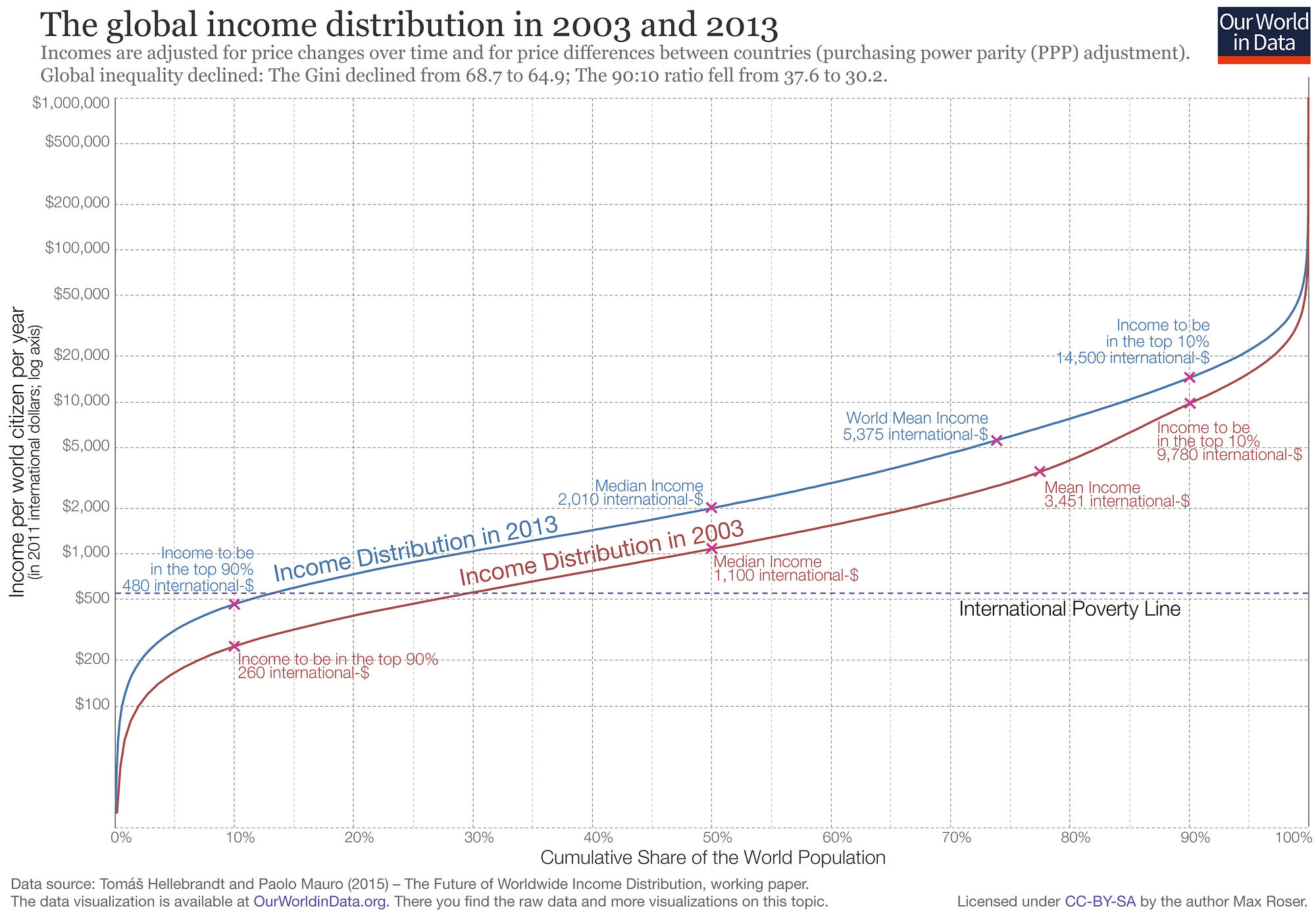 Global income distribution showing decline in Gini coefficient.
Global income distribution showing decline in Gini coefficient.
In summary, when looking at inequalities, the wealth distribution may be getting more skewed within some countries, but overall, because overall levels of wealth have increased most rapidly in the poorest nations, even those at the bottom of the income level are better off. I won’t go into the debate about whether inequality is even negative, but, taking a long-term worldwide view of the situation, it does not appear to be worse now.
Conclusions
The news is not only misinforming you about the world but, by promoting a false picture, it’s stealing something valuable: the joy that comes with seeing the world is getting better. While it’s important to be realistic about the challenges we face in the short term, it’s also critical to take a look at the big picture and realize that all of our collective efforts are making a difference.
People around the world are moving out of poverty into the middle class, and, as a result, living longer, healthier, more enjoyable lives.
I would like to end on one final chart which highlights the most important part of The Reality Project: when we realize that worldwide poverty is decreasing it should give us confidence that efforts to eliminate poverty are not foolish. Although the greatest contributor to declining poverty is (most likely) commerce, poverty reduction efforts such as those advocated by the United Nations are also vital. If you think poverty rates are increasing, then your only conclusion must be that these programs don’t work. If, on the other hand, you have dug into the data as we did and discovered the true state of the world, you realize these efforts have made a difference.
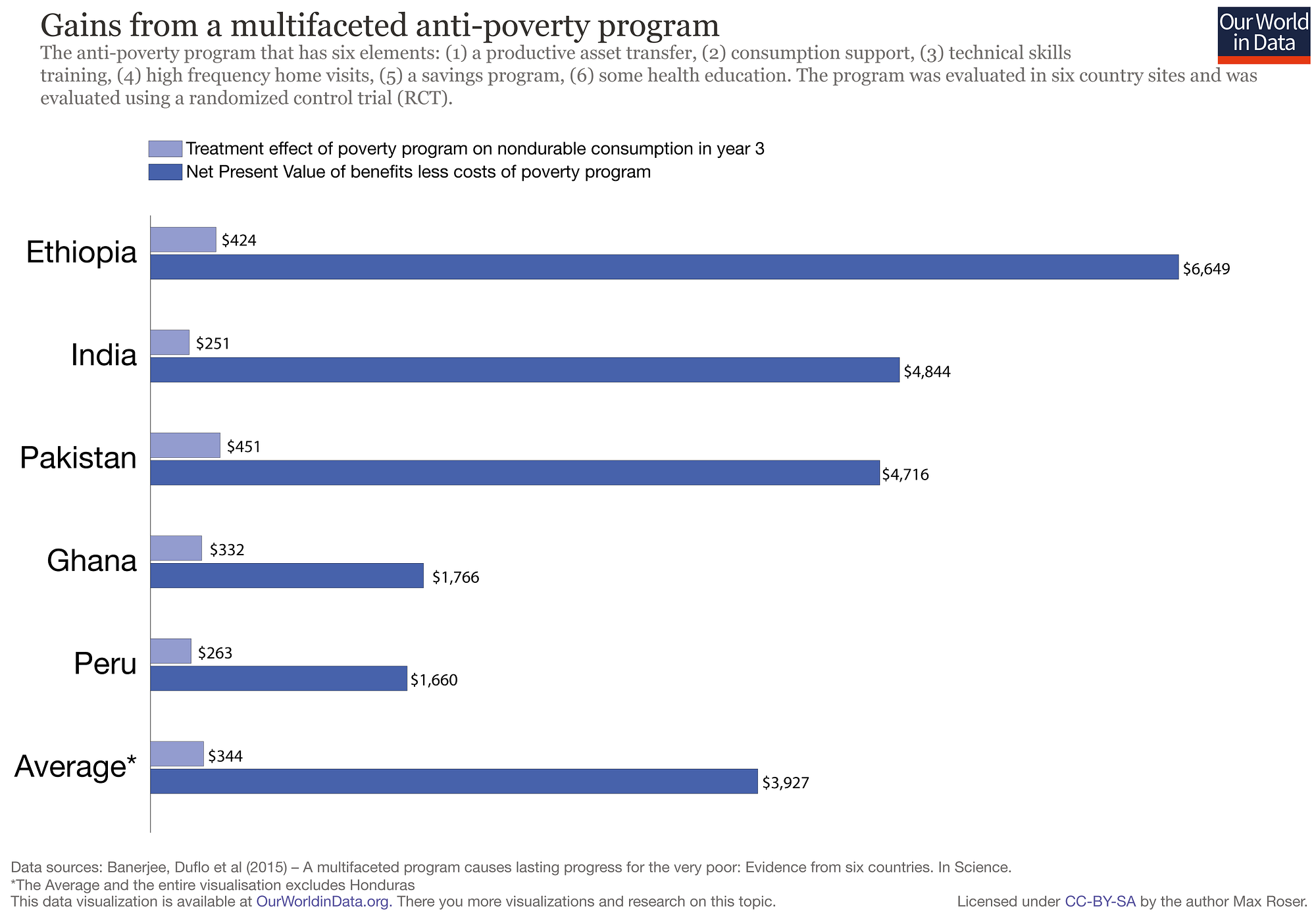 Effectiveness of anti-poverty programs (source)
Effectiveness of anti-poverty programs (source)
The poverty reduction program delivered benefits to the recipients far exceeding costs (read the details in “A Multifaceted Program Causes Lasting Progress for the Very Poor: Evidence from Six Countries”). The next time someone claims there will always be poor people and there’s no use in helping them, gently correct them, not with opinions, but with data.
Sources
In addition to the sources listed throughout the article, here are some resources for your own research. I welcome any discussion.
- Our World in Data: Extreme Poverty
- Our World in Data: Economic Growth
- Raw Data: Worldbank
- “The Decline of Extreme Poverty in Perspective”
- Factfulness: Ten Reasons We’re Wrong About the World — and Why Things Are Better Than You Thinkby Hans Rosling
- The Rational Optimist: How Prosperity Evolves by Matt Ridley
As always, I welcome feedback, conversation, and constructive dissent. I can be reached on Twitter @koehrsen_will.
